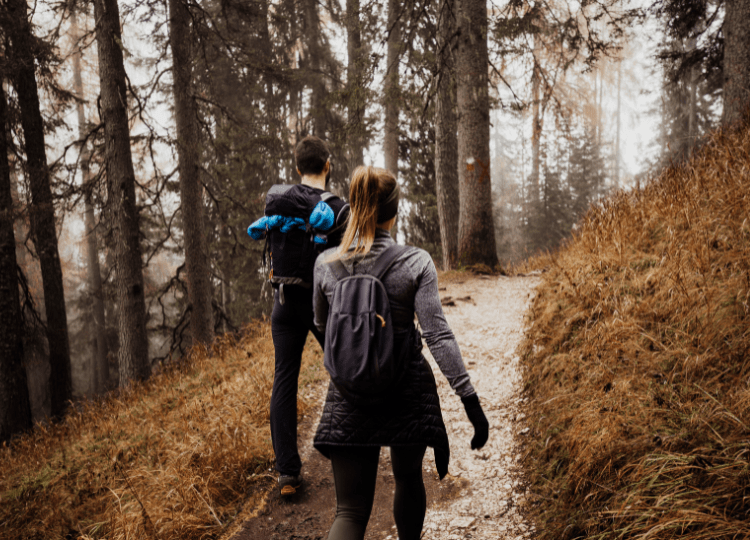Winter hiking looks romantic in photos, but when your fingers are numb and your jacket’s soaked, that “peaceful solitude” can feel more like poor judgment.
The truth is, with the right preparation and mindset, hiking through cold weather can be one of the most rewarding outdoor experiences you’ll ever have.
The air feels sharper, the trails are quieter, and the world looks completely transformed. The goal isn’t to tough it out, it’s to know how to move comfortably through it.
The Mental Shift That Changes Everything
Summer hiking is easy to love. You throw on a shirt, grab a water bottle, and go. Winter hiking demands more thought, but that’s part of its appeal. You’re planning layers, food, water, and timing like someone who’s got it together.
The reward for that effort isn’t just a photo of snow-dusted pines. It’s the quiet confidence that comes from not letting weather dictate your life. When you walk through a frosty forest and realize you’re warm, hydrated, and steady, it’s strangely empowering.
Preparation becomes its own kind of freedom.
Keeping Warm Without Overheating
You’ll sweat on a winter hike even if it’s freezing. That’s where layering smartly matters. Start with a moisture-wicking base, add an insulating layer that traps heat, and finish with a shell that blocks wind and snow.
It’s not about piling on fabric, it’s about balance. Remove layers when you start climbing or the sun hits, and put them back before you stop. The moment you let sweat chill on your skin, the cold wins.
Keeping your body dry is what keeps you safe. Your goal isn’t to avoid sweating altogether but to manage it like a pro. When the weather drops below freezing, even a small mistake like skipping gloves for “just a minute” can remind you how unforgiving the cold can be.
Why Stretching Before The Trail Matters
Before your boots hit the first icy switchback, loosen up. Cold muscles are less forgiving, and that stiffness can sneak up on you once you’re halfway up a ridge. Incorporating stretches for hiking into your pre-hike ritual doesn’t have to look like a yoga session on the trailhead.
Think dynamic, simple moves that get blood flowing: ankle rolls, leg swings, gentle lunges. It’s about waking up the muscles that will stabilize you on uneven terrain. The bonus? Fewer slips, less soreness, and a steadier rhythm as you find your pace. When your body’s already alert and responsive, you can focus more on the scenery and less on the twinges in your calves.
Your Feet Decide How The Day Goes
Every winter hiker learns fast that comfort lives and dies by their feet. Wet, cold toes can ruin an otherwise perfect morning. Wool or synthetic blend socks are non-negotiable, but the real upgrade comes from outdoor socks that prepare you for your adventures and protect you from blisters, all while keeping you comfortable.
They wick moisture, regulate temperature, and hold their shape even after hours of trekking. Pair them with waterproof boots that actually breathe and make sure your laces aren’t cutting circulation. It’s worth testing your boots and socks together before a big hike. The right combo can mean the difference between powering through another mile or counting steps until the car.
Food, Water, And Timing Make The Difference
Cold weather dulls thirst and appetite, which can trick you into skipping breaks. Don’t. Eat and drink more often than you think you need. Your body burns calories faster just staying warm. Trail mix, jerky, and small snacks you can eat without stopping go a long way. Keep water bottles insulated or stored upside down to prevent freezing at the mouthpiece.
Time your hike with daylight in mind since trails darken earlier under heavy clouds or forest cover. Planning ahead isn’t just about safety, it’s about getting to actually enjoy the stillness instead of worrying about the clock.
What Makes Winter Hiking Worth It
There’s something almost meditative about seeing your breath hang in the air as the woods stand silent around you. It’s not adrenaline that keeps people coming back to frozen trails, it’s clarity.
The noise of everyday life doesn’t follow you into that quiet. You move slower, notice more, and feel a kind of calm that’s hard to find anywhere else. Winter hiking strips things down to their basics. You, the trail, the air, and the steady rhythm of your boots. When you get it right, it’s less about conquering nature and more about syncing with it.
Bottom Line
Winter hiking isn’t about proving toughness, it’s about learning how to be comfortable in discomfort until it doesn’t feel like discomfort anymore. The cold sharpens your focus and rewards those who pay attention.
Get the gear right, move smartly, stretch before you start, and keep your feet dry and warm. When you do, you’ll realize winter trails aren’t something to endure, they’re something to savor. The best part is, you’ll come back from the cold feeling more alive than when you left.
